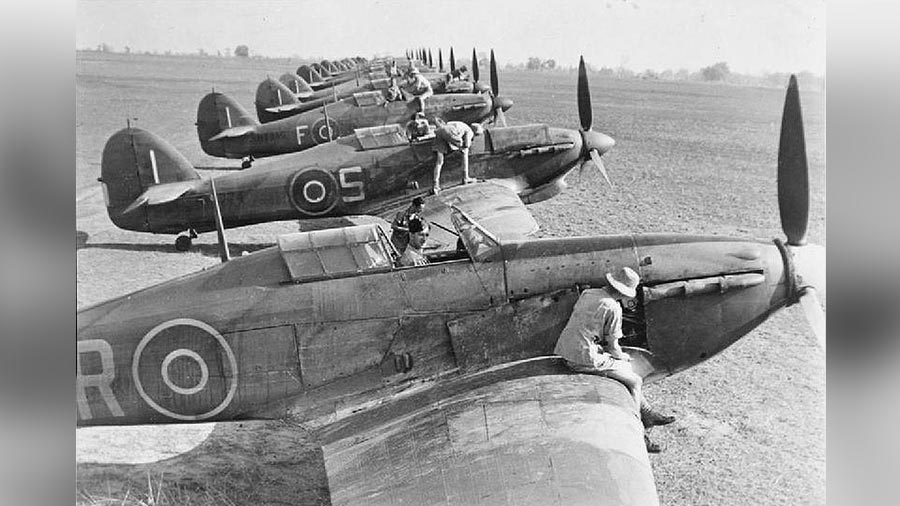A World War II-era Chinese cemetery tucked away in the rather non-descript cantonment town of Ramgarh in the state of Jharkhand in no way falls under the category of popular tourist destinations. No battle took place at Ramgarh and neither was it targeted during the World War II. So one can wonder as to what a war cemetery is doing there.
The cemetery features a huge gate with an Obelisk-shaped tower with a plaque in the middle of the premises. Other than that, there is a two-storeyed Buddhist temple and two huts in the vicinity. The ground floor of the temple has a memorial tablet of fallen soldiers along with flags of India and Republic of China (Taiwan). The first floor has a statue of Buddha.

The gate of the Chinese Cemetery at Ramgarh, Jharkhand
Many of the graves with larger tombstones, painted in white, have memorial stones written in Chinese. However, a large number of unpainted graves with a single stone have Unknown Warrior written on them. The cemetery accommodates more than 600 graves, and yet only 40-odd ones have been identified.
The town of Ramgarh was initially a prisoner’s camp housing several Italian and German prisoners of War, until it was converted into a training camp on August 26, 1942, for training Chinese soldiers financed by the British while the Americans provided the necessary training for fighting at the Burma front against the almost invincible Japanese Army.
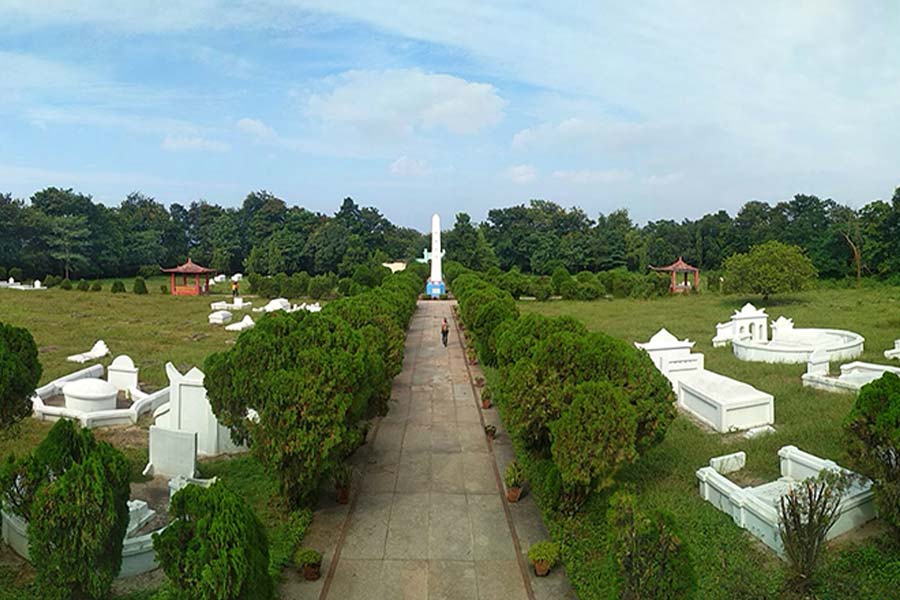
A wide-angle view of the Chinese Cemetery at Ramgarh in Jharkhand
At the entry gate of the cemetery, there is a plaque. It says “This cemetery is a permanent home to the heroes of the Republic of China who sacrificed their lives and died with honor in a combined operation with the British and American forces to build the China-India highway and successfully preventing the Japanese forces from occupying India and not allowing them to join the German forces in the Middle East”.
There is a lingering question here. If these soldiers were all fighting for the same cause, why there is an exclusive war cemetery only for the Chinese at Ramgarh?
A World War II Story
To answer to our question, we need to take a closer look at the incidents which took place after the Japanese bombed Pearl Harbour on December 7, 1941, and unwillingly dragged the USA into the World War II. The option left with Americans was to do strategic bombing of Japan after building bases at China, their ally country at that time.

Chiang Kai-shek, commander-in-chief of the National Revolutionary Army, and the leader of the Republic of China in mainland China from 1928 until 1949 Wikimedia Commons
China was having an all-out war with Japan which predated the World War II. Chiang Kai-shek, the leader of the Republic of China (ROC) in mainland China from 1928 until 1949 refused to surrender and carried on resistance after retreating inland.
It was impossible for China to win the war on its own. This seemed to be a great opportunity for the Americans to join hand with the Chinese in order to fight a common enemy. However, American observers and even President Roosevelt found Chinese forces to be politically fractured, poorly trained, and tactically passive. The British also had doubts about Chinese army’s capability.
The British finally accepted help from Chinese Expeditionary Force, an expeditionary unit of China’s National Revolutionary Army but with reluctance. Nevertheless, the British and Chinese forces lost Rangoon to the Japanese in February 1942. In March 1942, the Chinese Expeditionary Forces slowly entered Burma while the British forces evacuated from Rangoon.
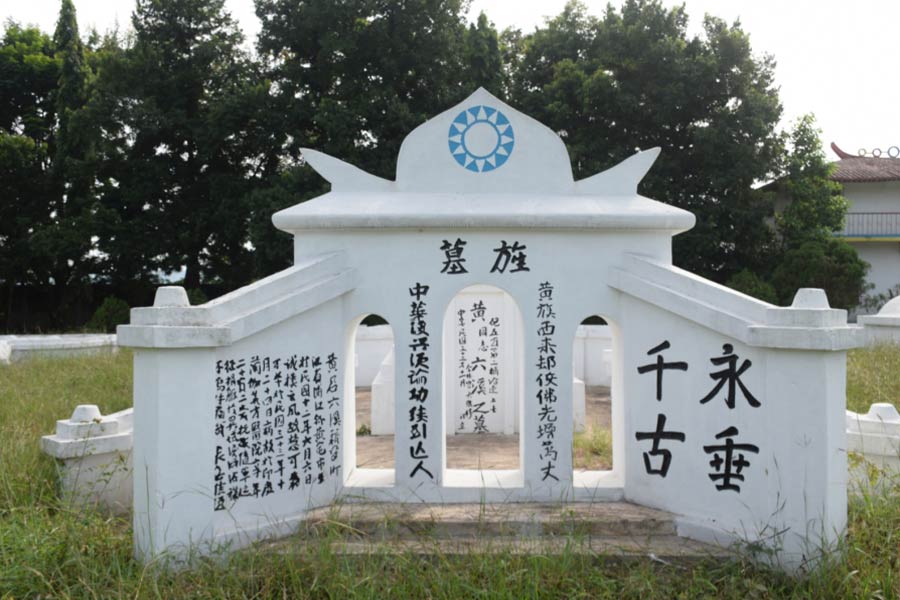
One of the 40-odd graves at Ramgarh Chinese Cemetery that have been identified
Ultimately, US Army Chief of Staff George Catlett Marshall assigned the post of commander of American force in China-Burma-India (CBI) Theater to an old friend Joseph Stilwell, who was a battalion commander with the 15th Regime at Tinjanin in Northern China, from 1924 and 1927. CBI was the United States military designation during World War II for the China and Southeast Asia.
Initial setup faced by Joseph Stilwell
Joseph Stilwell arrived in Burma on March 22, 1942, and led the Chinese 200th Division in the defence of Toungoo, a town in between Mandalay and Rangoon. The battle ended with the retreating Chinese troops. Finally, the country fell to the Japanese. The defeat resulted in the closure of the ‘Burma Road’, which severed China’s supply routes on land and sea. It forced Stilwell to lead a party of 115 through the jungle on foot to Assam in India, which later was known as the ‘Stilwell Stride’.
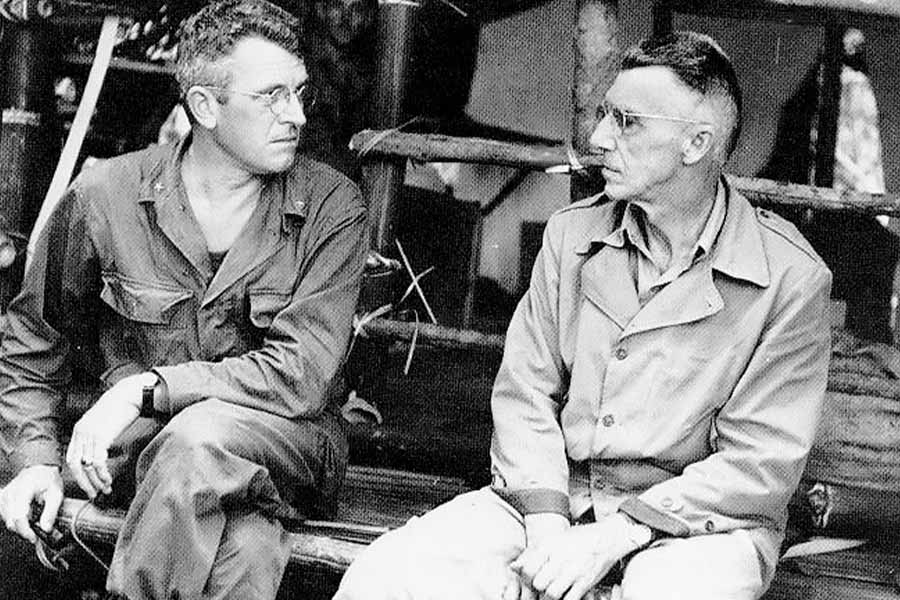
Brigade General Frank D. Merrill (left) and Lieutenant General Joseph W. Stilwell (right) meet near Naubum, Burma Wikimedia Commons
By the middle of 1942, Burma was in Japanese hands. China was miserably isolated and there was a change of Japanese attacking India.
A significant number of soldiers from the Chinese Expeditionary Force crossed rivers and mountains and marched back over 200 miles deprived of proper food, water or medical care to arrive at India after rigorous fighting at Burma.
The Ramgarh Training Camp and the ‘X’ Force.
After the Japanese victory disrupted Stilwell’s plans, he devised an alternative strategy to train Chinese soldiers with American experts at Ramgarh, a former PoW camp near a railhead. Chiang Kai-shek approved the plan on April 27, 1942, as there was inadequate capacity to supply force within China.
Initially, only Chinese troops retreating from Burma were trained which included members of the 38th Division from the 66th Army, followed by the 22nd Division and the 5th Corps under Maj. Gen. Liao Yai Shiang. American personnel, led by Brigadier General Frederick McCabe, joined in mid-1942. The 22nd, 38th, and later 30th and 50th Divisions were flown over the ‘Hump’ (The Himalayas) from China. Together these Chinese soldiers formed the ‘X’ Force to reopen the land route to China via the Ledo Road.
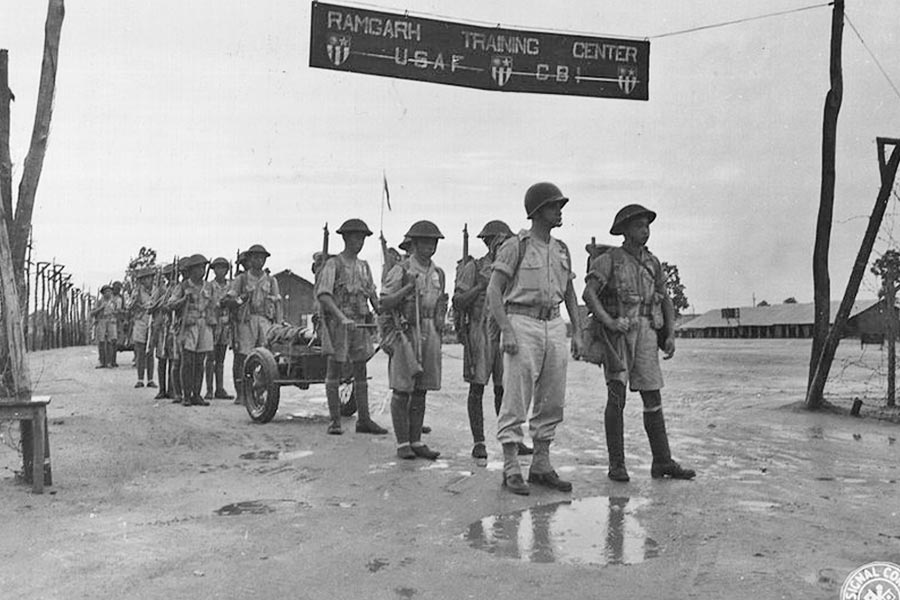
Chinese troops at Ramgarh Training Centre Wikimedia Commons
The Ramgarh Training Centre was established in utmost secrecy and its existence not disclosed until after the war.
Stilwell faced frustration with Chinese officers’ lack of aggression until the arrival of the US 5307th Composite Unit. Also known by its code name GALAHAD, the 5307th Composite Unit was popularly known as “Merrill’s Marauders” named after Frank Merrill who was in command of this unit.
Their first operation in February-March 1943, supported by the 22nd and 38th Divisions, saw heavy Japanese casualties with minimal allied losses, aided by local Kachin support. Challenges persisted, including attacks on the Nhpum Ga airstrip, Merrill's health issues, and pressure to capture Myitkyina from the American President, which eventually led to the deployment of China’s ‘Y Force’ to support the operation. The Y Force was the Second Chinese Expeditionary Force and its mission was to assist Allied operations. The Chinese and Kachins’ numbers were important as Merrill’s Marauders were reduced to half their original strength.
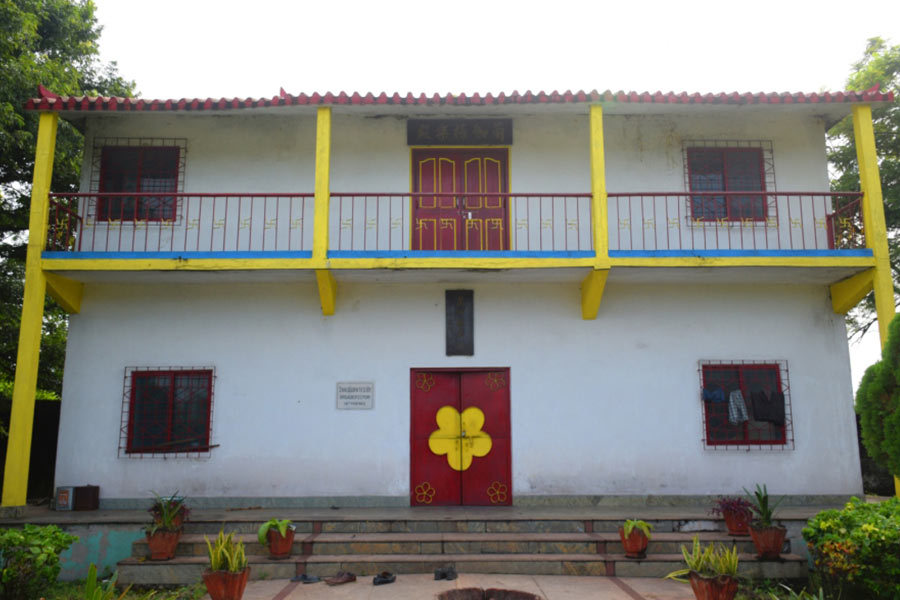
A Chinese temple inside premises of Ramgarh Chinese Cemetery
On May 17, 1944, Allied forces launched an assault on Myitkyina, quickly capturing the airfield but facing a prolonged battle for the city. The Ledo Road finally opened, connecting the old Burma Road to China. Afterward, the US built more air bases in China, and following continued Japanese resistance, President Truman ordered atomic bombs on Hiroshima and Nagasaki in August 1945, bringing World War II to an end. The Ledo Road and the upgraded portion of the Burma Road from Mongyu to Kunming were later named the Stilwell Road.
What happened with the dead?
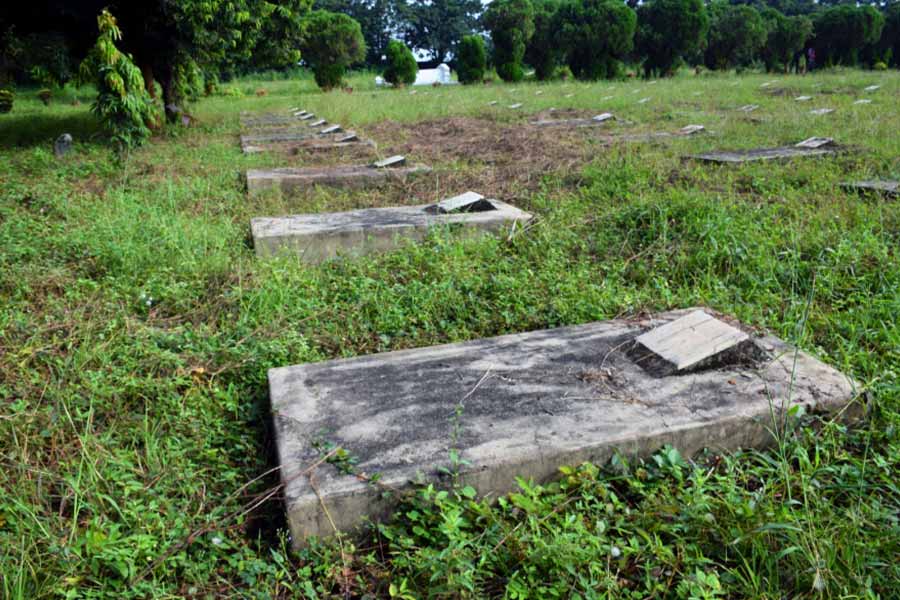
Rows of unidentified graves at Ramgarh Chinese Cemetery with ‘Unknown Warrior’ tablets
Unlike US and Britain, Nationalist China did not establish an office which handles war cemeteries in domestic and foreign territories. The Euro-American Allies were not obligated to make final arrangements for fallen Chinese soldiers.
Chinese soldiers’ graves and other smaller burial sites sprouted along the Burma Road stretching from Kunming to Lashio. In India, another twenty thousand Chinese officers and soldiers were buried in five main sites.
Under these circumstances, the Nationalist military command in India wanted to build a military cemetery in Ramgarh. US and Britain tried to pass the task of financing the Chinese Military Cemetery in Ramgarh to each other.
Ultimately in 1945, the Chinese Army in India turned to the Nationalist government. Zheng Dongguo (alias Cheng Tung–Kuo), field commander in the Republic of China National Revolutionary Army requested that the Nationalist government dispense 80,000 rupees and that too before departure of Chinese Army from India.
Finally, the Chinese Ministry of Military Administration approved the plan of cremating the bodies, placing the remains in earthen urns and adding signage on their graves. The Chinese and American sides were to accomplish the burial task together. This arrangement gave a new meaning to China being a “third-rank ally.” It’s dead received a minimal courtesy. Initially, the Chinese Buddhist monks living at the cemetery were to provide the upkeep on a monthly salary of 150 rupees.
Meanwhile the U.S. government was simultaneously making arrangements to collect the bodies of their soldiers. 2,028 bodies of American soldiers were transported to Shanghai and from there to the United States via air.
This is why there is no American war cemetery in Ramgarh, but only a Chinese War cemetery exists.
In 1983, the station commander of Ramgarh Cantonment Brigadier S.C. Puri took out an extensive effort to renovate it. At present it is maintained by Taiwanese Embassy at New Delhi. The caretaker said to me that representative from Taiwanese embassy visit it every year.
The plaque at the memorial mentions December 1944, but in all probabilities, it may be the foundation month and the cemetery was completed at a later date.
Linh D. Vu of Arizona State University mentions in the article ‘Bones of Contention: China’s World War II Military Graves in India, Burma, and Papua New Guinea’ (Page 63) published in the Journal of Chinese Military History 8 (2019) that in May 1945, Colonel Kernan reported from Ramgarh that the construction of the Chinese cemetery was a few days from completion as is evident from his correspondence papers. The cemetery might have been built during middle of 1945.
As per the memorial plaque, the cemetery has four sections. The North side was built by Ho Ying Chin, General Commander of the Chinese Army (1890-1987), Chiang Kai-Shek General Isimo (1887-1975) took care of the eastern side, Zheng Dongguo (pronounced Cheng Tung–Kuo, 1903-1991), field commander in the Republic of China National Revolutionary Army erected monuments on the South side and finally General Lo Cho Ying (1896-1961), Chief of Staff to American General Stillwell was responsible for construction of the tombs on the West Side.
On January 12, 2017, consul-general at the Chinese consulate in Kolkata, Ma Zhanwu requested the Indian government to turn the cemetery into a tourist spot, which was contested by Tien Chung-kwang head of the Taipei Economic and Cultural Centre (TECC) in India as because the Chinese soldiers buried there were soldiers of Chiang Kai Shek’s Republic of China and no way related to People’s Republic of China.
The important thing here is that the long forgotten Chinese allies of the Americans who played a major role to stop the near invincible Japanese force from entering India and reopening of the Burma Road is no more a long-lost chapter for the present generation.

